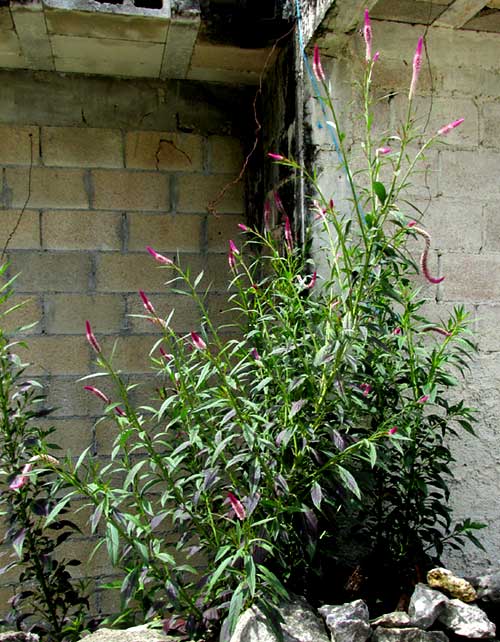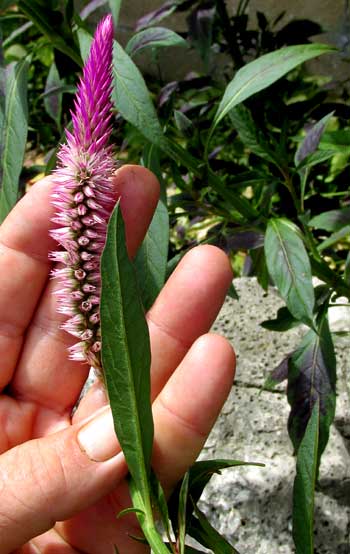Excerpts from Jim Conrad's
Naturalist Newsletter
from the August 28, 2016 Newsletter issued from Hacienda Chichen Resort beside Chichén Itzá Ruins; limestone bedrock; elevation ~39m (~128ft), N20.675°, W88.569°; central Yucatán state, MÉXICO
SPIKED COCKSCOMB
This week I had to take the bike into Pisté for repairs, so while the mechanic worked I walked around town looking for special plants. One of the most interesting is shown below, leaning over a rock fence separating a cinderblock house from the street

Up closer, the flowering heads are seen to be spikes of crowded flowers, the spike's bottom-most blossoms opening first, the top ones maturing last, as shown below:

Very close up, the flowers are seen to consist of 2-5 petal-like parts best referred to as perianth segments, surrounding five stamens, which in turn surround an ovary topped by a slender, purplish style and small, knobby stigma, as seen below:

There we can also see that below each flower there arise stiff, sharp-tipped scales somewhat similar to but larger than the perianth segments.
Often this plant is referred to as the Spiked Cockscomb. Its binomial often is given as Celosia spicata , but the trend seems to be to consider the taxon as a variety of the broader Celosia argentea, and call it CELOSIA ARGENTEA var. CRITSATA. It's a member of the Amaranth Family, which makes sense because that family's main field mark is its many tiny flowers with papery perianth segments intermingled with stiff, often showy, papery scales.
The name cockscomb refers to one form of Celosia argentea that sometimes scatters its flowers and scales across a thick, leathery, fan-shaped, modified stem vaguely looking like a rooster's comb, though typically they're much more frilly, or "crenellated," than any actual rooster's comb.
Texas A&M University's Celosia page tells us that cockscombs come in three main types: plumes; crests, and; spikes. Crests are like rooster combs, plumes look like frozen flames, and our pictures show the spike type. The online Floridata Plant Encyclopedia recognizes another form, The Childsii Group, with rounded flowering heads.
Though many new and ever-more-weird and colorful forms of cockscomb are being created, this is and ol ornamental plant. My Grandmother Conrad was especially fond of them, the crenelated crest type, back in rural Kentucky during the 1950s. As the Floridata Encyclopedia says, "In the garden, celosia flowers can last up to 8 weeks. Dried flowerheads last indefinitely. The Cristata Group cultivars were selected from mutations and are among the most bizarre of flowers."